Summary
A review of synthetic reductions utilized in the clandestine manufacture of amphetamine and methamphetamine is presented. General discussions on the mechanism of heterogenous catalysis, dissolving metals, hydrides and non-metal reductions used in the manufacture of amphetamine and methamphetamine with over 90 references are presented.
Introduction
This review addresses reductions in clandestine methamphetamine and amphetamine synthesis. Central to the diverse routes published for the synthesis of amphetamine and methamphetamine is a reductive step at some point in the synthesis. Of 95 references surveyed concerning the synthesis of these controlled drugs, all but ten utilize a reductive approach. Since such diversity exists in these approahes, we felt that a composite literature review and discussion of the chemistry involved would help forensic chemists charged with investigating these clandestine laboratories. Secondly, we felt that a composite reference list would be of assistance in correlating notes or procedures found in clandestine laboratory sites to the open literature. Finally, two literature review articles in the forensic area have appeared and both were devoid of extensive references1,2.
An overview of synthetic approaches to methamphetamine and amphetamine utilized reductive routes is outlined in Tables 1 and 2. Table 1 is organized by the type of catalytic surface or reductive species; i.e. Pd, Pt, LiAlH4, HCOOH etc. Table 2 is organized by the synthetic route or intermediate; i.e. Leuckart, Schiff base, oxime, nitrostyrene, etc. Figures 1-12 illustrate the chemical formulas of the chemical reduction routes to amphetamine and methamphetamine. References [3,72] are annotated with the type of reductive catalyst/reagent and route utilized. Chemical Abstracts citations [C.A. Vol, Page (year)] are included for each reference for ease of cross reference with cryptic notes often found in clandestine laboratory sites. Finally, the recurrent use of the terminology "open literature" refers to legitimate, accredited journals as opposed to underground publications or notes passed between clandestine manufacturers.
Table 1
(Meth)amphetamine
Heterogenous Reactions(external source of hydrogen) |
|
| A | Pd3-17,39 |
| B | Pd/C7,9,12,15-17 |
| C | Pd/BaSO45,8 |
| D | Pt18-24 |
| E | Pt/C23 |
| F | CuO, CaSO4, BaSO425 |
| G | Raney Nickel (Ni-Al)26-38 |
Heterogenous Reactions(internal source of hydrogen) |
|
| H | CaH2/Pd, HCl39 |
Dissolving Metal Reduction('Internal' Electrolytic) |
|
| I | Al/Hg40-45 |
| J | Al/Pd, HCl54 |
| K | Na/Alcohol46-49 |
| L | Na/Hg50-51 |
| M | Fe/HCl52-53 |
| N | Zn/HCl54 |
| O | Zn/Cu, HCl54 |
| P | Zn/Pd, HCl54 |
| Q | Zn/Cu/Pd, HCl54 |
Metal Hydride Reductions(Source of Hydride) |
|
| R | NaBH455-56 |
| S | NaBH3CN57 |
| T | LiAlH458-62 |
Non-metal Reductions |
|
| U | HI63;* |
| V | HCOOH64-72 |
Table 2
(Meth)amphetamine via Reduction
Methamphetamine via |
Route # |
|
| Ephedrine | ||
| A | Direct3,8,17; J.Heagy(*) | 1 |
| B | Halo analog3-5,17-19,39,54 | 1 |
| C | Sulfate ester6 | 1 |
| D | Phosphate ester7 | 1 |
| E | Perchlorate ester8 | 1 |
| Schiff's Base10,20-22,25,40-44,46,55,57 | 2 |
|
| Thiazole47 | 9 |
|
| Leuckart58,64,66 | 8 |
|
| d-Phenylalanine carbamate | 10 |
|
| N-Formyl58,66 | 8 |
|
Amphetamine via |
Route # |
|
| Oxime11-12,30-31,48-49,60 | 3 |
|
| Nitrostyrene13,32-33,35,50,61 | 4 |
|
| 2-Keto Oxime14-16,36,38,51 | 5 |
|
| Hydrazone23-24 | 6 |
|
| Schiff base26-29,45 | 2 |
|
| 3-Iodo analog62 | 11 |
|
| Leuckart65, 67-70 | 8 |
|
| Demercuration56 | 12 |
|
* J. Heagy, personal communication, from information gathered by attending clandestine laboratory sites.
Heterogenous Catalysis

The role of heterogenous catalytic hydrogenation and hydrogenolysis in organic synthesis is replete in the literature. However, the mechanism of the catalyst's role has remained elusive due mainly to the difficulty of studying such heterogenous systems. Recent research in this area has shown that a system charged with H2 and D2 in the prescense of a catalyst yields HD. This has been interpreted as the catalyst's coordination with molecular H2 and weakening or disrupting of the H-H bond87-88. Studies by Maier et al (pers. commun.) in which the catalytic surface has been coated with SiO2, have revealed that the H-H (which penetrates the SiO2 layer to coordinate with the catalytic surface) is truly ruptured, yielding °H. Furthermore, hydrogenation of an organic species (incapable of penetrating the SiO2 layer) occurred. This suggests that coordination between the organic moiety and the catalytic surface may not be necessary. "Selectivity"for an organic substrate in some catalytic metal hydrogenation systems has recently been shown to be dependent upon the topology of the catalytic surface89. Further work in this area will be followed with interest.
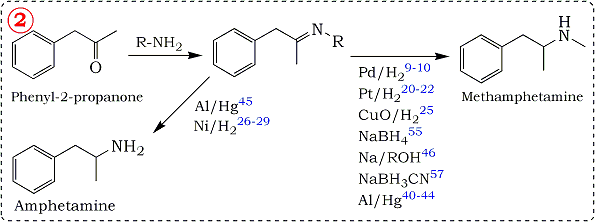
Heterogenous catalytic hydrogenation of ephedrine to methamphetamine in clandestine laboratories is often achieved with palladium3-8,15,17,39; the use of platinum (Adams catalysis) is second in frequency18,19 (Fig 1). Similar correlations apply to the reduction of phenylpropanolamine to amphetamine utilizing palladium, platinum and Raney Nickel.
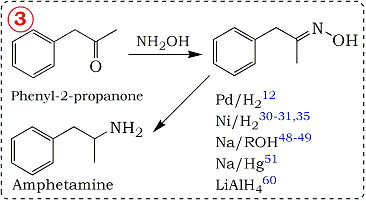
Hydrogenolysis of ephedrine or phenylpropanolamine (here hydrogenolysis is defined as reduction of C-X) is not a result of reduction of the benzylic carbon-OH bond. The actual moiety reduced is C-X, where X refers to the halogen3-5,17-19,39,54, sulfate6, phosphate7 or perchlorate8 esters (Fig 1). This moiety (C-X) may be produced in situ3,17 or syntheized externally, isolated and then reduced4,9,18-19,39,54. The stereochemistry and analytical methology for methamphetamine prepared from ephedrine and pseudoephedrine has recently been addressed92-93.
Heterogenous catalysis has been used to reduce the imine bond of Schiff bases formed with phenyl-2-propanone and ammonia or methylamine in order to produce amphetamine26-29 or methamphetamine9-10,20-22,25 (Fig 2). When heterogenous catalysis is utilized in this Schiff base reduction, a competing reaction, that of P2P reduction to 1-phenyl-2-propanol, limits the yield of amphetamine or methamphetamine. Additions of large exceses of the amine component in these reactions have been employed to suppress the ketone reduction. This has limited applicability, since the optimum pH for the Schiff's bases is between 6 and 7.

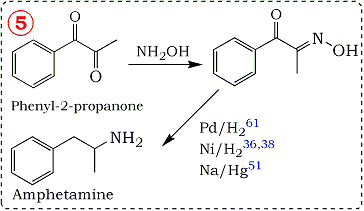
Other clandestine routes, although less popular, which have open literature references utilizing heterogenous catalysis for the synthesis of amphetamine are oxime reduction12,30-31,35 (Fig 3), nitrostyrene reduction13,32-33 (Fig 4), 2-keto-oxime reductions16,36,38 (Fig 5) and hydrazone reduction23,34 (Fig 6).

Precursors to amphetamine (phenylpropanolamine) and methamphetamine (ephedrine) have been synthesized with the aid of heterogenous catalysis16,38(Fig 5).
Dissolving Metal Reductions
Dissolving metal reductions, in particular aluminum, continue to be the most popular synthetic route to methamphetamine and amphetamine in clandestine laboratories in the United States. Although molecular H2 is produced as the metal dissolves, this is generally considered a detriment to the reduction of the organic species. The actual reduction mechanism does not involve molecular H2, but is, in fact, a result of an "internal electrolytic process". Electron transfer from the metal to a heteroatom results in a radical carbon, which abstracts hydrogen from solution to complete reduction. In metals where higher oxidation states are present (i.e. Al, Mg, Zn) dimers may form as a result of intramolecular radical combination54,90-91.
Poisoning of catalysis in one approach used to minimize rapid dissolution of the metal and to abate evolution of H2. Amalgams made between sodium and mercury have the effect of diminishing the activity of the parent metal, thus slowing dissolution of the reducing species. Amalgamation between aluminum and mercury has the added benefit of preventing oxide formation on the surfce of the aluminum in contact with air. Aluminum-mercury amalgam serves as a poison to the metal somewhere between the extremes of the over-active metal and the inactive metal oxide.

In the clandestine manufacture of amphetamine and methamphetamine the most popular route is via aluminum-mercury amalgam reduction of the Schiff base adduct of phenyl-2-propanone (P2P) and the appropriate amine40-45 (Fig 2). This popularity persists despite US Government control (Schedule II) of P2P in 1980. This controlled status has resulted in an upsurge in the clandestine manufacture of P2P. A variey of synthetic routes have surfaced in clandestine laboratories, primarily through phenylacetic acid73-77 (Fig 7). Alternatives to the phenylacetic acid (from now on a reporting schedule in some states) synthesis of P2P have appeared78-79. One approach to P2P utilizes a dissolving metal reduction of nitrostyrene with iron and hydrochloric acid52-53 (Fig 4).

Clandestine laboratories which utilize other dissolving metal reduction routes have been infrequently encountered. However, reduction of a Schiff base to methamphetamine46 (Fig 2) and of 5-phenyl-4-methylthiazole to amphetamine47 (Fig 8 ) using sodium in alcohol are cited in the open lliterature. Additionally, Na/alcohol reduction of an oxime48-49 (Fig 3), Na/Hg amalgam reduction of a nitrostyrene50 (Fig 4) or a 2-keto-oxime51 (Fig 5) to amphetamine and Zinc/HCl reductions of chloro analogs of ephedrine to methamphetamine54 (Fig 1) are also cited in the literature.
Metal Hydride Reductions
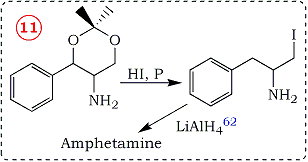
Metal hydride reductions have not captured the imagination of clandestine laboratory chemists like the remainder of the scientific community. This fact is probably the result of their inability to utilize current Chemical Abstracts nomenclature, wherein most literature references with metal hydrides appear. Metal hydrides function by transfer of a hydride ion to the electron-deficient center (typically carbon) of a double bond. Protonation is effected on the electron-rich center via the solvent media in case of NaBH4 or product workup in the case of LiAlH4.
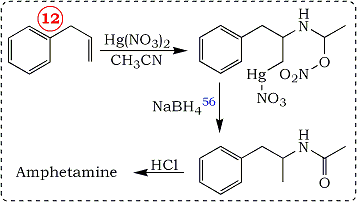
The infrequent use of metal hydride reducing agents in cannot be attributed to the lack of open literature references in these agents55-62. Methanmphetamine has been produced in clandestine laboratory sites via NaBH4 reduction of the Schiff base adduct of P2P and methylamime following a procedure of Weichet et al55 (Fig 2). Unfortunately, the activity of NaBH4 is sufficient to reduce the ketone of P2P, and this is a competing reaction. This is not the case with the more selective reducing agent NaBH3CN whose activity is dependent upon the pH of the reaction media57. Lithium aluminium hydride, whose activity is greater and therefore less selective than NaBH4 has been used to produce methamphetamine or amphetamine through the reduction of a variety of functional groups; i.e. formyl58 (Fig 9), carbamate59(Fig 10), oxime60 (Fig 3), nitrostyrenes61 (Fig 4) and halogen analogs62 (Fig 11). Sodium borohydride has also been used in a demercuration procedure route followed by acid hydrolysis to amphetamine (in a clandestine laboratory) as in Fig 1256.

Non-metal Reductions
Non-metal reductions to amphetamine and methamphetamine have been what might be termed as "fads" in clandestine laboratory synthesis within the United States. In the early and mid 1970's, the Leuckart synthesis, which employs formic acid, was the polular clandestine route to amphetamine and methamphetamine. For whatever reason, this route, which is still very common in Western Europe, lost popularity in the United States by the end of the 1970s. In the early 1980's the hydriodic acid reduction of ephedrine to methamphetamine began increasing in frequency in the Southwestern and Western areas of the United States. Although several literature references link the Leuckart synthesis (Fig 9) to amphetamine67-69 and methamhetamine64-66, no open literature reference directly links hydriodic acid reduction of a benzylic alcohol to the production of methamphetamine (Fig 1). Several general benzylic alcohols have been reduced to their aliphatic counterparts63. However, this "cross application" of chemical synthesis would require a level of chemical knowledge not common among clandestine chemists.
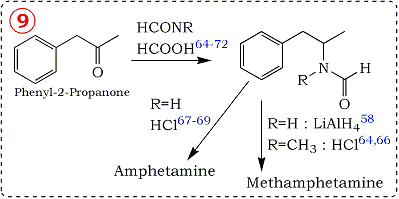
The mechanism of the Leuckart reaction has been studied65,71-72 and shown to be a free radical process initiated by formic acid. Unfortunately, the mechanism of the hydriodic acid reduction has not been established. It seems clear that the benzylic alcohol of ephedrine undergoes a substitution reaction with iodine. However, the mechanism of the carbon-halogen reduction is inconjecture; i. e. hydride transfer, internal electrolysis via dispropornation of iodine, or elevated temperatures decomposition of HI to H2 and I2 whereby H2 reduces the C-I bond63.
Conclusion
In this review we have addressed reductive approaches to amphetamine and methamphetamine via heterogenous catalysis, dissolving metals, metal hydrides and non-metal reductions. The chemistry of these varied approaches has been highlighted with emphasis on the role of the reducing species. It may be concluded that there are many options available to clandestine chemists (see Fig 1-12). However, in actual practice, the three most frequently encountered routes in the United States are:
- The aluminum foil reduction of the Schiff base adduct of P2P and methylamine40-44
- The palladium catalyzed reduction of the chloro analog of ephedrine to methamphetamine4-5 and
- The hydriodic acid reduction of ephedrine to methamphetamine63; J. Heagy*.